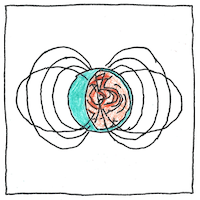Robert Duncan,
Christopher Thompson,
Chryssa Kouveliotou
astrophysics

|
Magnetar
Classical bursts of gamma rays, soft gamma repeaters, and anomalous X-ray pulsars could be magnetars— neutron stars with extremely high magnetic fields, rapid rotations, and susceptibility to starquakes.
Soft gamma repeater
Not a normal burst of gamma rays, this object emitted photons closer to the range of X-rays, and repeated. Chryssa Kouveliotou calculated that each burst slowed the object’s rotation by just a tiny bit and showed the object was likely to be a magnetar.
Altering the quantum vacuum
A magnetic field strong enough polarizes the vacuum, rendering it birefringent, splits and merges photons, distorts and magnifies images, and dramatically increases the density of virtual electron-positron pairs so that the vacuum becomes unstable. When your atoms stretch into narrow cylinders and your molecules look like thin polymer chains, you are too dead to enjoy the odd effects.



The interior of a magnetar is extremely dense. Even so, to generate such intense magnetic fields, this dense material must be turbulent, like a magnetohydrodynamic dynamo. A proton-superconductor phase of matter is thought to support the persistence of generated fields.
See also in The book of science:
Readings in wikipedia:
Other readings: